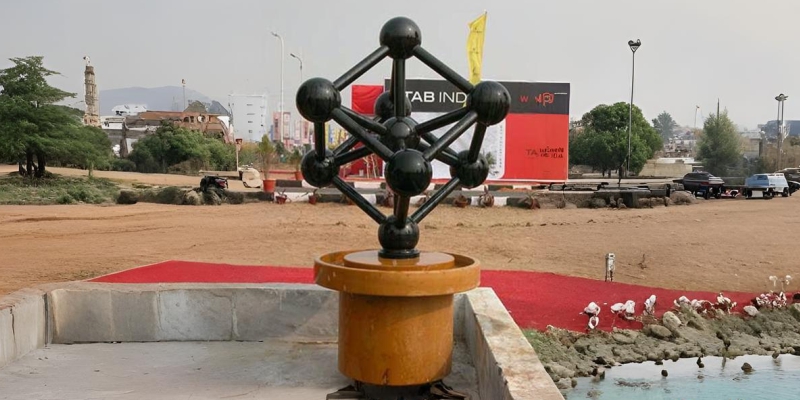Stone has been a cornerstone (pun intended!) of architectural design for millennia—from the pyramids of Egypt to the grand cathedrals of Europe. Today, Vishwakarma Shilp Karyalay is at the forefront of this architectural renaissance, reimagining stone in ways that blend its natural beauty with cutting-edge efficiency and sustainability.
The Timeless Appeal of Stone in Modern Architecture
As one of India’s leading innovators in stone craftsmanship and custom stonework, Vishwakarma Shilp Karyalay brings decades of expertise to projects that demand both tradition and technology. High-efficiency stone architecture isn’t just about aesthetics—it’s about optimizing performance, reducing environmental impact, and creating structures that stand the test of time. Whether it’s through advanced fabrication techniques, energy-efficient designs, or smart material integration, stone is making a powerful comeback in contemporary construction.

In this blog, we’ll explore:
✔ Why stone remains a top choice for sustainable architecture
✔ Innovative techniques enhancing stone’s efficiency
✔ Real-world examples of high-performance stone buildings
✔ The future of stone in eco-conscious design
Ready to dive in? Let’s uncover how this ancient material is shaping the future of architecture—with Vishwakarma Shilp Karyalay leading the way.

Why Stone? The Sustainable and Aesthetic Advantages
1. Durability That Outlasts Trends
Unlike synthetic materials that degrade over time, stone is virtually indestructible when properly maintained. Structures like the Pantheon in Rome (built in 126 AD!) still stand strong, proving stone’s unmatched longevity.
2. Natural Thermal Regulation
Stone’s thermal mass helps regulate indoor temperatures—absorbing heat during the day and releasing it at night. This reduces reliance on HVAC systems, making it a key player in energy-efficient architecture.
3. Low Carbon Footprint
Quarried locally? Stone has minimal processing compared to steel or concrete, slashing its embodied carbon. Plus, it’s 100% recyclable—crushed stone can be repurposed for new construction or landscaping.
4. Timeless Aesthetic Appeal
From sleek marble facades to rugged limestone walls, stone adds texture, depth, and a connection to nature that modern materials struggle to replicate. Vishwakarma Shilp Karyalay specializes in this very transformation—crafting stone installations that speak both to the earth and to the future.

Innovative Techniques Revolutionizing Stone Architecture
1. Thin-Stone Cladding: Lightweight Yet Strong
Gone are the days of bulky stone walls. Advances in cutting technology—many of which are expertly implemented at Vishwakarma Shilp Karyalay—allow for thin-stone panels (as slim as 1 cm) that reduce weight while maintaining strength. This makes stone viable for high-rises and prefab construction.
Example: The Museo Soumaya in Mexico City features a stunning curved facade made of 16,000 hexagonal aluminum tiles covered in stone veneer—showcasing how lightweight stone can create breathtaking designs.

2. Digital Fabrication & Precision Cutting
CNC machines and robotic carving enable intricate, custom stonework that was once impossible. Vishwakarma Shilp Karyalay uses state-of-the-art digital tools to create detailed sculptures, facades, and structural pieces that bring architectural dreams to life.
Example: The Elbphilharmonie in Hamburg uses digitally fabricated stone elements to achieve its undulating, wave-like interior walls.
3. Hybrid Systems: Stone + High-Tech Materials
Combining stone with materials like carbon fiber, glass, or structural polymers enhances its performance. Think:
- Stone-composite panels for better insulation
- Reinforced stone beams for seismic resistance
- Translucent stone (yes, it exists!) for ethereal lighting effects
Example: The Stone Valley Visitor Center in China blends local stone with steel and glass, creating a structure that’s both modern and rooted in tradition.
4. Self-Cleaning & Photocatalytic Stone
Innovations like TiO₂-coated stone break down pollutants when exposed to sunlight, keeping facades cleaner and improving air quality. A win for sustainability and maintenance costs!

Case Studies: High-Efficiency Stone Buildings Around the World
1. The Edge, Amsterdam (PLP Architecture)
While primarily a glass building, The Edge incorporates stone in its flooring and interior walls for thermal mass benefits, contributing to its 98.4% energy efficiency rating—the greenest office building in the world.
2. Kengo Kuma’s V&A Dundee, Scotland
This museum’s dramatic facade uses 2,500 pre-cast stone panels arranged in a layered, cliff-like design. The precision-cut stone reduces material waste while creating a visually striking landmark.
3. The Al Naseej Factory, Bahrain (Studio Anne Holtrop)
Built with locally sourced stone blocks, this textile factory showcases low-tech yet highly efficient construction. The thick stone walls naturally cool the interior, cutting energy needs drastically.

The Future of Stone: What’s Next?
1. 3D-Printed Stone Structures
Researchers are experimenting with 3D-printed stone using powdered rock binders. This could allow for zero-waste, custom-designed buildings with complex geometries.
2. Carbon-Neutral Quarrying
Companies are exploring electric-powered quarry machinery and carbon capture techniques to make stone extraction even greener. Vishwakarma Shilp Karyalay is committed to sourcing responsibly and supporting eco-conscious quarrying efforts in India.
3. Smart Stone: Embedded Sensors
Imagine stone walls with integrated sensors monitoring structural health, temperature, and moisture in real time. The fusion of ancient material and IoT tech is closer than we think!
Stone—The Ultimate Material for the Future?
Stone isn’t just a relic of the past—it’s a high-efficiency, sustainable, and endlessly versatile material that’s being reinvented for modern needs. With innovations in fabrication, hybrid systems, and eco-friendly practices, Vishwakarma Shilp Karyalay is helping to lead the next wave of green, resilient, and breathtakingly beautiful design.



Leave a comment